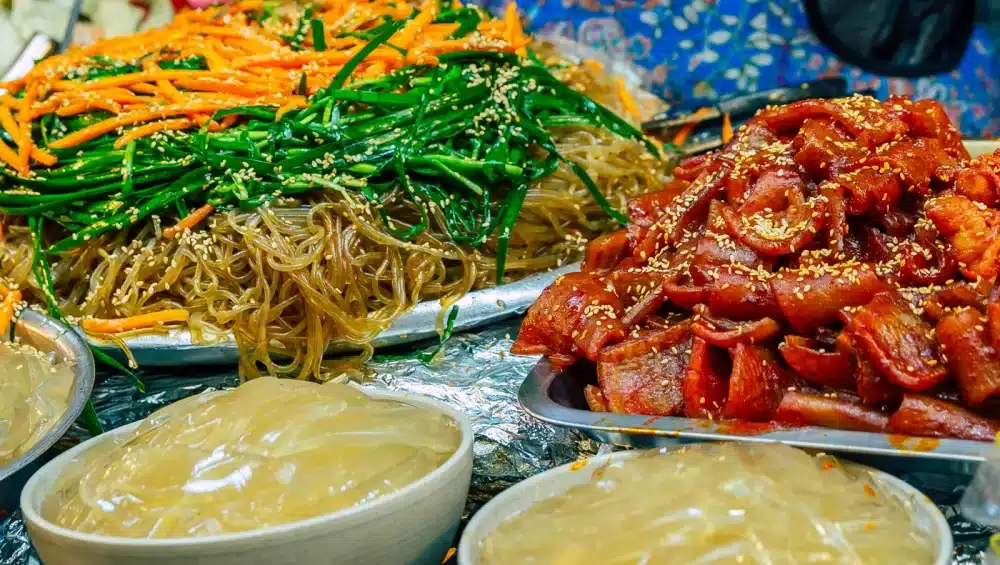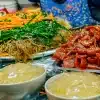Embark on a gastronomic adventure to the vibrant land of South Korea as we delve deep into the tantalizing world of its cuisine. South Korean food is a harmonious blend of bold flavors, fresh ingredients, and centuries-old culinary traditions. From sizzling barbecues to fiery kimchi, each dish tells a story and offers a unique sensory experience that will leave your taste buds tingling with delight. In this captivating journey, we will uncover the secrets behind some of South Korea’s most beloved dishes, explore the cultural significance of food in Korean society, and discover the intricate art of balancing flavors in their cuisine. So, whether you are a food enthusiast or simply intrigued by the cultural tapestry of South Korea, join us as we embark on a flavorsome expedition, where every bite is a celebration of the rich heritage and culinary prowess of this incredible country. Get ready to tantalize your senses and experience the delicious delights that South Korean cuisine has to offer.
Traditional South Korean Dishe
South Korean cuisine boasts a wide array of traditional dishes that reflect the country’s rich history and cultural heritage. One such dish is bibimbap, a hearty bowl of warm rice topped with an assortment of sautéed vegetables, meat, and a fried egg, all drizzled with spicy gochujang sauce. The colors and textures of the ingredients create a visually stunning presentation, while the combination of flavors creates a symphony of taste in every bite. Another popular dish is bulgogi, thinly sliced marinated beef or pork grilled to perfection. The meat is tender and juicy, with a sweet and savory marinade that caramelizes beautifully on the grill. These traditional dishes are often served with an array of banchan, which are small side dishes that add depth and variety to the meal. From pickled vegetables to spicy tofu, banchan offers a diverse range of flavors and textures that complement the main dishes.
South Korean cuisine is also known for its jajangmyeon, a comforting dish made with noodles and a thick black bean sauce. It is a staple in Korean-Chinese cuisine and is often enjoyed as a quick and satisfying meal. Another iconic dish is samgyetang, a nourishing chicken soup stuffed with ginseng, jujubes, and glutinous rice. It is believed to have medicinal properties and is commonly consumed during the hot summer months to replenish energy and boost health. These traditional dishes are just a glimpse into the vast culinary landscape of South Korea, each offering a unique taste and cultural significance.
Popular Street Foods in South Korea
South Korea is renowned for its vibrant street food culture, where bustling food stalls offer an array of delicious snacks and quick bites. One of the most popular street foods is tteokbokki, chewy rice cakes cooked in a spicy gochujang sauce. The combination of soft rice cakes and fiery sauce creates a mouthwatering explosion of flavors that will leave you craving for more. Another street food favorite is odeng, skewered fish cakes served in a warm and comforting broth. It is a popular choice during the chilly winter months and is enjoyed by both locals and visitors alike.
For those with a sweet tooth, South Korea offers a variety of delectable treats. Bungeoppang, a fish-shaped pastry filled with sweet red bean paste, is a popular street snack that is both visually appealing and delicious. Another sweet delight is hotteok, a fluffy pancake filled with a mixture of brown sugar, cinnamon, and nuts. It is often enjoyed during the winter months when the warm and gooey filling provides a comforting respite from the cold. These street foods not only provide a quick and tasty meal on the go but also offer a glimpse into the vibrant and dynamic food culture of South Korea.
Regional Variations in South Korean Cuisine
While South Korean cuisine as a whole is known for its bold flavors and spicy dishes, there are also distinct regional variations that showcase the unique culinary traditions of each area. One such example is Jeju cuisine, which is influenced by the abundant seafood found on Jeju Island. Fresh seafood such as abalone, sea urchin, and flatfish are commonly featured in Jeju dishes, creating a delicate and refined flavor profile.
On the other hand, the Gyeongsang region in the southeast is known for its spicy and hearty dishes. Gyeongsang cuisine often features fermented seafood and strong flavors, with dishes like gaengjung, a spicy and savory stir-fried squid dish, and sikhye, a sweet rice drink that is often enjoyed as a dessert.
In the Gangwon region, located in the northeastern part of South Korea, the cuisine is heavily influenced by the mountainous terrain. Dishes in this region often feature ingredients from the surrounding forests, such as mushrooms, wild herbs, and mountain vegetables. One popular dish is deodeok gui, grilled mountain root that has a unique and earthy flavor.
These regional variations add depth and diversity to South Korean cuisine, showcasing the unique flavors and culinary traditions of each area.
Unique Ingredients in South Korean Cooking
South Korean cuisine is known for its use of unique ingredients that add depth and complexity to dishes. One such ingredient is gochujang, a fermented chili paste that is a staple in Korean cooking. It is made from red chili peppers, glutinous rice, fermented soybeans, and salt, creating a rich and spicy flavor profile that is essential in many Korean dishes. Gochujang is often used as a marinade for grilled meats, a base for stews, or a condiment to add a kick of heat to any dish.
Another distinctive ingredient is doenjang, a fermented soybean paste that is similar to miso but with a stronger and more pungent flavor. It is commonly used as a base for soups and stews, adding depth and umami to the dish. Doenjang is also used as a condiment, often mixed with garlic and sesame oil to create a flavorful dipping sauce.
South Korean cuisine also makes use of perilla leaves, which are often used as a wrap for grilled meats or as a garnish for soups and stews. Perilla leaves have a distinct flavor that is reminiscent of mint and basil, adding a refreshing and aromatic element to dishes.
These unique ingredients are what give South Korean cuisine its distinctive flavors and make it a truly unique culinary experience.
Health Benefits of South Korean Cuisine
In addition to its delicious flavors, South Korean cuisine is also known for its health benefits. Many traditional Korean dishes are packed with nutrient-rich ingredients that contribute to overall well-being. For example, kimchi, a fermented vegetable side dish, is not only a staple in Korean cuisine but also a nutritional powerhouse. It is rich in vitamins, fiber, and beneficial bacteria that promote gut health. The fermentation process also enhances the nutritional content of the vegetables, making kimchi a wholesome and flavorful addition to any meal.
Another healthful ingredient in South Korean cuisine is ginseng, which is often used in soups, teas, and tonics. Ginseng is believed to have various health benefits, including boosting the immune system, improving cognitive function, and reducing inflammation. It is commonly used in traditional Korean medicine and is considered a valuable ingredient in maintaining overall health.
South Korean cuisine also emphasizes the use of fresh ingredients, such as vegetables, seafood, and lean meats. These whole foods provide essential nutrients and are often prepared using healthy cooking methods, such as grilling or steaming.
By embracing South Korean cuisine, not only do you get to enjoy a delicious and flavorful dining experience, but you also reap the health benefits that come along with it.
South Korean Cooking Techniques
South Korean cuisine is characterized by its unique cooking techniques that enhance the flavors of the ingredients and create a harmonious balance in each dish. One such technique is grilling, which is commonly used for meats, seafood, and even vegetables. Grilling imparts a smoky and charred flavor to the ingredients, creating a depth of taste that is both satisfying and delicious.
Another technique is fermentation, which is an integral part of South Korean cuisine. Fermentation not only adds complexity to the flavors but also enhances the nutritional content of the ingredients. Kimchi, doenjang, and gochujang are just a few examples of fermented foods that are commonly used in Korean cooking.
Stir-frying is another popular cooking technique in South Korean cuisine. It involves quickly cooking ingredients over high heat, resulting in a dish that is flavorful and vibrant. Stir-frying allows the flavors to meld together while retaining the natural textures and colors of the ingredients.
These cooking techniques, along with the careful selection and preparation of ingredients, contribute to the unique and tantalizing flavors of South Korean cuisine.
South Korean Food Etiquette and Dining Customs
In South Korean culture, food is not just about nourishment but also a way of connecting with others and showing respect. Understanding the dining customs and etiquette is important when experiencing South Korean cuisine.
One important aspect of South Korean dining etiquette is sharing. Many traditional Korean meals are served family-style, with multiple dishes placed in the center of the table for everyone to share. It is considered polite to wait for everyone to be served before starting to eat and to take small portions of each dish to ensure there is enough for everyone.
The use of chopsticks and spoons is also a significant part of South Korean dining customs. Chopsticks are used for picking up solid food items, while spoons are used for soups and rice. It is considered impolite to stick chopsticks upright in a bowl of rice, as it symbolizes death.
Bowing is a common form of greeting and showing respect in South Korea. When entering a restaurant or being served a dish, it is customary to bow slightly as a sign of gratitude and appreciation.
In addition to these customs, it is important to note that slurping noodles and making noise while eating is not considered rude in South Korean culture. In fact, it is seen as a sign of enjoyment and appreciation for the food.
By understanding and respecting these dining customs, you can fully immerse yourself in the South Korean dining experience and show appreciation for the culture and cuisine.
Famous South Korean Restaurants and Food Markets
South Korea is home to numerous renowned restaurants and food markets that offer a wide range of culinary delights. Gwangjang Market in Seoul is a must-visit destination for food enthusiasts. It is one of the oldest and largest traditional markets in South Korea, offering a plethora of street food stalls and vendors selling everything from fresh seafood to traditional snacks. The market is particularly famous for its bindaetteok, a savory pancake made with mung beans and various fillings.
Another popular food market is Noryangjin Fish Market, also located in Seoul. It is a seafood lover’s paradise, with rows of stalls selling an impressive variety of fresh fish, shellfish, and other seafood. Visitors can purchase their desired seafood and have it prepared on-site at one of the many nearby restaurants.
For those looking for an upscale dining experience, **Jungsik** in Seoul is a highly acclaimed restaurant that offers modern interpretations of traditional Korean cuisine. The restaurant has received multiple Michelin stars and is known for its innovative dishes that showcase the flavors and techniques of South Korean cooking.
These are just a few examples of the many exceptional restaurants and food markets that South Korea has to offer. Exploring these culinary destinations is an opportunity to indulge in the diverse flavors and culinary artistry of South Korean cuisine.
Conclusion: Embracing the Flavors of South Korean Cuisine
South Korean cuisine is a true celebration of flavors, culture, and tradition. From traditional dishes to vibrant street food, each bite transports you to a world of bold and tantalizing flavors. The unique ingredients, cooking techniques, and dining customs all contribute to the rich tapestry of South Korean cuisine.
Whether you are savoring a bowl of bibimbap or indulging in a spicy tteokbokki, every dish tells a story and offers a sensory experience that is both gratifying and memorable. South Korean cuisine is a testament to the country’s rich culinary heritage and serves as a gateway to understanding its vibrant culture.
So, embark on a culinary adventure and embrace the flavors of South Korean cuisine. Let your taste buds be captivated by the harmonious blend of flavors, the intricate balance of ingredients, and the undeniable passion that goes into every dish. From traditional classics to innovative creations, South Korean cuisine will leave you with a newfound appreciation for the art of food and the joy it brings.





